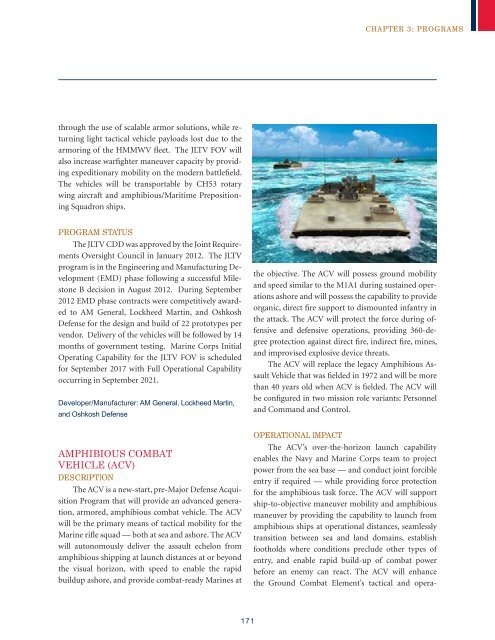USMC Concepts & Programs 2013 - Defense Innovation Marketplace
USMC Concepts & Programs 2013 - Defense Innovation Marketplace
USMC Concepts & Programs 2013 - Defense Innovation Marketplace
Create successful ePaper yourself
Turn your PDF publications into a flip-book with our unique Google optimized e-Paper software.
chapter 3: programs<br />
Amphibious Combat Vehicle<br />
(ACV)<br />
through the use of scalable armor solutions, while returning<br />
light tactical vehicle payloads lost due to the<br />
armoring of the HMMWV fleet. The JLTV FOV will<br />
also increase warfighter maneuver capacity by providing<br />
expeditionary mobility on the modern battlefield.<br />
The vehicles will be transportable by CH53 rotary<br />
wing aircraft and amphibious/Maritime Prepositioning<br />
Squadron ships.<br />
Program Status<br />
The JLTV CDD was approved by the Joint Requirements<br />
Oversight Council in January 2012. The JLTV<br />
program is in the Engineering and Manufacturing Development<br />
(EMD) phase following a successful Milestone<br />
B decision in August 2012. During September<br />
2012 EMD phase contracts were competitively awarded<br />
to AM General, Lockheed Martin, and Oshkosh<br />
<strong>Defense</strong> for the design and build of 22 prototypes per<br />
vendor. Delivery of the vehicles will be followed by 14<br />
months of government testing. Marine Corps Initial<br />
Operating Capability for the JLTV FOV is scheduled<br />
for September 2017 with Full Operational Capability<br />
occurring in September 2021.<br />
Developer/Manufacturer: AM General, Lockheed Martin,<br />
and Oshkosh <strong>Defense</strong><br />
Amphibious Combat<br />
Vehicle (ACV)<br />
Description<br />
The ACV is a new-start, pre-Major <strong>Defense</strong> Acquisition<br />
Program that will provide an advanced generation,<br />
armored, amphibious combat vehicle. The ACV<br />
will be the primary means of tactical mobility for the<br />
Marine rifle squad — both at sea and ashore. The ACV<br />
will autonomously deliver the assault echelon from<br />
amphibious shipping at launch distances at or beyond<br />
the visual horizon, with speed to enable the rapid<br />
buildup ashore, and provide combat-ready Marines at<br />
the objective. The ACV will possess ground mobility<br />
and speed similar to the M1A1 during sustained operations<br />
ashore and will possess the capability to provide<br />
organic, direct fire support to dismounted infantry in<br />
the attack. The ACV will protect the force during offensive<br />
and defensive operations, providing 360-degree<br />
protection against direct fire, indirect fire, mines,<br />
and improvised explosive device threats.<br />
The ACV will replace the legacy Amphibious Assault<br />
Vehicle that was fielded in 1972 and will be more<br />
than 40 years old when ACV is fielded. The ACV will<br />
be configured in two mission role variants: Personnel<br />
and Command and Control.<br />
Operational Impact<br />
The ACV’s over-the-horizon launch capability<br />
enables the Navy and Marine Corps team to project<br />
power from the sea base — and conduct joint forcible<br />
entry if required — while providing force protection<br />
for the amphibious task force. The ACV will support<br />
ship-to-objective maneuver mobility and amphibious<br />
maneuver by providing the capability to launch from<br />
amphibious ships at operational distances, seamlessly<br />
transition between sea and land domains, establish<br />
footholds where conditions preclude other types of<br />
entry, and enable rapid build-up of combat power<br />
before an enemy can react. The ACV will enhance<br />
the Ground Combat Element’s tactical and opera-<br />
171

















